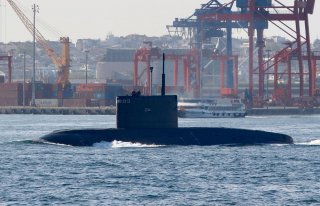China’s Kilo-Class Submarines: “Black Holes” in the South China Sea?
These Russian-made boats are no joke.
These Soviet-designed submarines are the backbone of China’s non-nuclear submarine fleet—and are very hard to detect. Here’s how they may give China an edge in the South China Sea.
Soviet Union Surplus
The Kilo-class was originally a Soviet-designed boat that entered service in 1980. They are relatively small diesel-electric attack submarines intended for both anti-surface warfare and anti-submarine warfare. What makes them special is that they have reduced acoustic signatures that are hard to track, known colloquially as “black holes.”
The Kilo-class is outfitted with anechoic tiles that adhere to the outside of the submarine’s hull. Anechoic tiles are essentially rubberized tiles that have been impregnated with air bubbles of varying size. The air bubbles are optimized for absorbing enemy sonar at different depths and can distort the returning sonar signal from enemy ships or submarines in order to make the sub harder to track.
Because the Kilo-class uses diesel-electric propulsion, they have shorter range and endurance than nuclear powered submarines. Naval expert H. I. Sutton explained that the Kilo-class “uses heavy-duty lead-acid batteries to power the propeller. These are occasionally recharged using diesel generators, an arrangement known as diesel-electric.”
Recharging the Kilo’s batteries takes time away from missions, and requires surfacing or raising a snorkel near the surface which is risky because the sub might be detected. In addition to oxygen, other mission limitations include the crew’s food and water supplies, as well as diesel fuel for the on-board diesel generators used in battery recharging.
Kilo-class submarines have a crew complement of fifty-two and can be out on patrol for over a month—up to forty-five days. It’s maximum dive depth is about 300 meters, or a thousand feet, and reportedly the subs have a range of 12,000 kilometers, or about 7,500 miles.
Chinese Optimum
The People’s Liberation Army Navy ordered the first Kilos from Russia in 1994 and has bought up more quite readily since, purchasing two upgraded Kilo variants in 1996, and eight more upgraded Kilos in 2002.
China’s Kilo-class are optimized for the defense of China’s coasts and for military actions against Taiwan due to both their size and stealth.
Because of the Kilo’s relatively small size, it can operate and maneuver in the shallow coastal waters near China, or in the South China Sea more easily than large nuclear submarines, which can struggle to maneuver at low depths. Despite having significantly less endurance than other nuclear submarines, diesel-electric submarines, especially compact hulls, can be more capable than nuclear submarines in some circumstances.
The latest Kilo variants are among the quietest submarines in the Chinese and Russian navies. Upgraded Kilos are “slightly longer in length—the sub’s submerged displacement is around 4,000 tons—and features improved engines, an improved combat system, as well as new noise reduction technology.” Coupled with sonar-absorbent anechoic tiles, Kilos are deadly silent.
A2/AD
Chinese submarine technology has progressed in leaps and bounds, and the Kilo-class may be to thank. Even though China does seem to be more intent on projecting force farther and farther away from the Chinese mainland, the Kilo-class is nevertheless the backbone of China’s anti-access/area denial strategy at sea—especially close to home. It would be wise for surface ships in China’s backyard to be wary.
Caleb Larson is a Defense Writer with The National Interest. He holds a Master of Public Policy and covers U.S. and Russian security, European defense issues, and German politics and culture.
Image: Reuters

